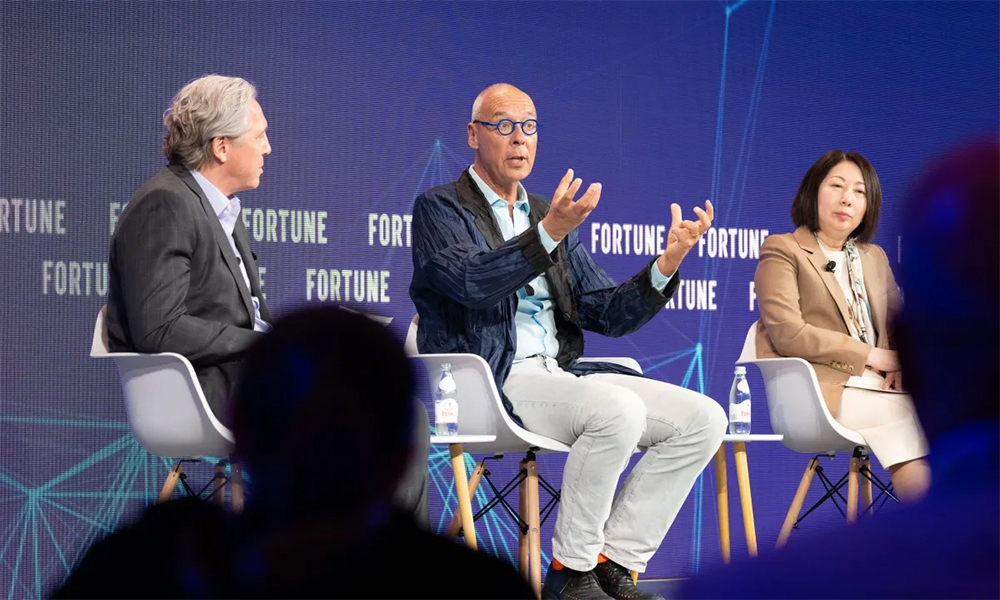
两周前,日本央行时隔17年首次把利率上调至零以上,从负0.1%上调到0至0.1%,结束了全球主要经济体最后的负利率政策,并向经济学家们暗示日本长达30年的经济低迷可能终将结束。
日本银行(Bank of Japan)的助理行长清水季子(Tokiko Shimizu)认为,负利率政策的结束代表日本经济迎来了拐点,尽管按照国际银行业标准来说,日本加息的幅度微乎其微。
3月27日,清水季子在中国香港举办的《财富》创新论坛上表示:“加息的幅度很小,仅上调了10个基点。但这对于日本经济而言却是非常重要的一步。”
这位中央银行家指出,日本央行加息这一历史性举措,体现出日本国内一个新的现实,即经过多年滞胀之后,工资和物价均呈上涨趋势。
清水季子谈到了日本公司与工会之间最近的工资谈判,她说:“我们之所以决定加息,是因为工资和物价之间正在进入良性循环。”谈判的结果是工资提高了5.28%,为33年来的最大涨薪幅度。
清水季子称,其他G7和G20经济体的央行,比日本央行更担心工资快速上涨。公司通过涨价来应对更高的劳动成本和日益恶化的通货膨胀,这反过来会鼓励上班族以后要求进一步涨薪。在20世纪70年代,经济学家们把西方经济体的持续通胀和经济萧条归咎于这种工资-物价螺旋,并担心许多国家可能再次发生这种情况。
但日本所面对的情况截然不同——它数十年来一直在应对持续通货紧缩,通货紧缩导致国内消费低迷、工资上涨停滞和资产价格下跌。对清水季子和她的同事们来说,今年3月的工资谈判表明,日本最终有望看到一种更正常的通胀模式。
3月27日,清水季子预测,日本不太可能进一步加息。“我们预测未来几年的物价波动幅度大约为2%。这意味着我们并不认为加息是必要的。”
今年2月,日本的整体通胀率提高到2.8%。这是该数字连续23个月达到或超过日本央行制定的2%的目标。
日本是否将回归?
日本最近的加息,只是全球第四大经济体将重回正轨这一论调的一部分。日本的股票市场现在已经超过了1989年12月,即日本经济泡沫达到顶峰时创下的纪录。
资深日本观察者、冲绳科学技术大学院大学(Okinawa Institute for Science and Technology)的董事杰斯珀·科尔在3月27日表示,日本可能终于已经度过了拐点。
科尔用辞职人数来证明劳动力市场变得更加紧张。“过去四五年,[辞职率]大幅提高。”他说。“日本的下一代年轻精英们更有冒险精神。”有三分之二的日本年轻人选择了创业。
在高层职位上,也有一些变化。科尔称:“从日本领先上市公司新任命的首席执行官们的年龄来看,首席执行官的年龄已经从69岁下降到57岁。”
公司也在恢复对日本的投资。今年2月,领先的芯片制造商台积电(Taiwan Semiconductor Manufacturing Company)在日本九州岛熊本县的一家工厂开业。九州岛有时候被称为“硅岛”。
最后,科尔表示,日本正在成为一个“移民超级大国”,这个传统封闭的国家吸引了越来越多的移民。
科尔解释道:“现在有320万外国人生活在日本,其中240万人实际上是在日本工作。我在20世纪80年代中期来到日本时,在日外国人的数量只有50万人。”
人口老龄化
清水季子和科尔都提到了日本经济面临的一个严峻挑战:日益萎缩的劳动力。日本是全球人口老龄化最严重的国家之一,十多年来,日本政府一直试图提高生育率,却未能成功。
这意味着日本必须以更少的人口维持增长。清水季子认为,解决这个问题的答案是借助机器人、自动化和人工智能等技术。
她说:“相比西方人,日本人喜欢机器人。”她用著名日本卡通角色哆啦A梦的毛绒玩具,来证明自己的观点。她解释道,机器人可以帮助鼓励更多的日本女性和老年人进入劳动力市场,壮大国内的劳动力。
但科尔认为人口结构的变化,能够给日本的经济注入活力。
科尔表示:“日本正处于人口结构的甜蜜点,因为国内四分之一人口已经超过70岁,而且婴儿潮一代将会优雅地离世。”
他说:“现在我们有更年轻的一代人,他们拥有全新的观念。这些年轻人现在离开了政府部门,但他们没有加入三菱(Mitsubishi Corporation)等大公司,而是选择了自己创业。”(财富中文网)
译者:刘进龙
审校:汪皓
两周前,日本央行时隔17年首次把利率上调至零以上,从负0.1%上调到0至0.1%,结束了全球主要经济体最后的负利率政策,并向经济学家们暗示日本长达30年的经济低迷可能终将结束。
日本银行(Bank of Japan)的助理行长清水季子(Tokiko Shimizu)认为,负利率政策的结束代表日本经济迎来了拐点,尽管按照国际银行业标准来说,日本加息的幅度微乎其微。
3月27日,清水季子在中国香港举办的《财富》创新论坛上表示:“加息的幅度很小,仅上调了10个基点。但这对于日本经济而言却是非常重要的一步。”
这位中央银行家指出,日本央行加息这一历史性举措,体现出日本国内一个新的现实,即经过多年滞胀之后,工资和物价均呈上涨趋势。
清水季子谈到了日本公司与工会之间最近的工资谈判,她说:“我们之所以决定加息,是因为工资和物价之间正在进入良性循环。”谈判的结果是工资提高了5.28%,为33年来的最大涨薪幅度。
清水季子称,其他G7和G20经济体的央行,比日本央行更担心工资快速上涨。公司通过涨价来应对更高的劳动成本和日益恶化的通货膨胀,这反过来会鼓励上班族以后要求进一步涨薪。在20世纪70年代,经济学家们把西方经济体的持续通胀和经济萧条归咎于这种工资-物价螺旋,并担心许多国家可能再次发生这种情况。
但日本所面对的情况截然不同——它数十年来一直在应对持续通货紧缩,通货紧缩导致国内消费低迷、工资上涨停滞和资产价格下跌。对清水季子和她的同事们来说,今年3月的工资谈判表明,日本最终有望看到一种更正常的通胀模式。
3月27日,清水季子预测,日本不太可能进一步加息。“我们预测未来几年的物价波动幅度大约为2%。这意味着我们并不认为加息是必要的。”
今年2月,日本的整体通胀率提高到2.8%。这是该数字连续23个月达到或超过日本央行制定的2%的目标。
日本是否将回归?
日本最近的加息,只是全球第四大经济体将重回正轨这一论调的一部分。日本的股票市场现在已经超过了1989年12月,即日本经济泡沫达到顶峰时创下的纪录。
资深日本观察者、冲绳科学技术大学院大学(Okinawa Institute for Science and Technology)的董事杰斯珀·科尔在3月27日表示,日本可能终于已经度过了拐点。
科尔用辞职人数来证明劳动力市场变得更加紧张。“过去四五年,[辞职率]大幅提高。”他说。“日本的下一代年轻精英们更有冒险精神。”有三分之二的日本年轻人选择了创业。
在高层职位上,也有一些变化。科尔称:“从日本领先上市公司新任命的首席执行官们的年龄来看,首席执行官的年龄已经从69岁下降到57岁。”
公司也在恢复对日本的投资。今年2月,领先的芯片制造商台积电(Taiwan Semiconductor Manufacturing Company)在日本九州岛熊本县的一家工厂开业。九州岛有时候被称为“硅岛”。
最后,科尔表示,日本正在成为一个“移民超级大国”,这个传统封闭的国家吸引了越来越多的移民。
科尔解释道:“现在有320万外国人生活在日本,其中240万人实际上是在日本工作。我在20世纪80年代中期来到日本时,在日外国人的数量只有50万人。”
人口老龄化
清水季子和科尔都提到了日本经济面临的一个严峻挑战:日益萎缩的劳动力。日本是全球人口老龄化最严重的国家之一,十多年来,日本政府一直试图提高生育率,却未能成功。
这意味着日本必须以更少的人口维持增长。清水季子认为,解决这个问题的答案是借助机器人、自动化和人工智能等技术。
她说:“相比西方人,日本人喜欢机器人。”她用著名日本卡通角色哆啦A梦的毛绒玩具,来证明自己的观点。她解释道,机器人可以帮助鼓励更多的日本女性和老年人进入劳动力市场,壮大国内的劳动力。
但科尔认为人口结构的变化,能够给日本的经济注入活力。
科尔表示:“日本正处于人口结构的甜蜜点,因为国内四分之一人口已经超过70岁,而且婴儿潮一代将会优雅地离世。”
他说:“现在我们有更年轻的一代人,他们拥有全新的观念。这些年轻人现在离开了政府部门,但他们没有加入三菱(Mitsubishi Corporation)等大公司,而是选择了自己创业。”(财富中文网)
译者:刘进龙
审校:汪皓
Japan’s central bank raised interest rates above zero for the first time in 17 years just under two weeks ago. It lifted interest rates to 0-0.1%, up from -0.1%, ending the world’s last negative interest rate regime among major economies—and signaling to economists that Japan’s 30-year slump may finally be over.
Tokiko Shimizu, an assistant governor at the Bank of Japan, is one of those who sees the ending of the negative rate regime as symbolic of Japan turning a corner—even if the rate increase is tiny by international banking standards.
“The step itself is very small—10 basis points,” she said on March 27 at the Fortune Innovation Forum in Hong Kong. “But it’s a very great step for the Japanese economy.”
For the central banker, this historic step by the Japanese central bank reflects a new reality in the country, where wages and prices are rising after years of stagnation.
“The reason we decided to change it is because the virtuous cycle between wages and price is going on,” she said, pointing to recent wage negotiations between Japanese companies and labor unions. Discussions led to a 5.28% pay increase, the largest raise in 33 years.
Shimizu noted that her colleagues in other G7 and G20 economies are more worried than Japan’s central bank is about fast wage growth. Companies raise prices to account for higher labor costs, worsening inflation, and, in turn, encouraging workers to ask for more pay increases later. Economists blamed this wage-price spiral for persistent inflation and economic stagnation in Western economies in the 1970s, and worries about this happening again persist in many countries.
Yet Japan has instead faced an altogether different fight—it has battled persistent deflation for decades, causing lower consumption, stagnant wages and falling asset prices. For Shimizu and her colleagues, March’s wage negotiations show that Japan might finally be seeing a more normal pattern of inflation.
On March 27, Shimizu forecast that further interest rate increases were unlikely. “We expect the price movement in coming years to be around 2%. That means we don’t see any interest rate hike [to be] necessary.”
Headline inflation accelerated to 2.8% in February. It marked the 23rd consecutive month the figure has met or surpassed the central bank’s 2% price target.
Is Japan back?
Japan’s recent interest rate hike is just part of a larger narrative that the world’s fourth-largest economy is back on track. The country’s stock markets have now surpassed records set all the way back in December 1989, at the peak of Japan’s bubble economy.
Jesper Koll, board director at the Okinawa Institute for Science and Technology and a veteran Japan watcher, said on March 27 the country may have finally turned a corner.
Koll pointed to the number of people quitting their jobs as an indication of a tighter labor market. “Over the past four or five years, this [quit rate] has shot up very dramatically,” Koll said. “The elite, the young, the next generation of Japan are now taking risks,” he continued, with two-thirds of young Japanese now going to start-ups.
There are changes at the top too. “When you look at the age of the new CEOs that have been appointed by the leading companies in Japan by listed companies, the age of the CEO has dropped from 69 to 57,” Koll said.
Companies are also re-investing in Japan. Leading chipmaker Taiwan Semiconductor Manufacturing Company just opened a factory in Kumamoto prefecture on the island of Kyushu—sometimes called “Silicon Island”—in February.
Finally, Koll suggested that Japan was becoming an “immigration superpower,” with the traditionally-closed country attracting many more migrants.
“Now there are 3.2 million non-Japanese living in Japan, of which 2.4 million are actually working. When I showed up in Japan in the mid-1980s, there were barely 500,000,” Koll explained.
Aging population
Both Shimizu and Koll mentioned one significant challenge for the Japanese economy: Its shrinking workforce. Japan has one of the world’s oldest populations, and the country’s government has tried, and failed, to lift fertility rates for over a decade.
That means Japan will have to sustain growth with fewer people. For Shimizu, the answer to the problem comes through robots, automation and AI.
“Japanese people love robots, compared to Western people,” she said, using a stuffed toy of Doraemon, the famous Japanese cartoon robot cat, to reinforce her point. Robots can help Japan encourage more women and elderly to join the labor market, expanding the country’s workforce, she explained.
Koll, instead, sees demographic change as a way to reinvigorate Japan’s economy.
“Japan is in this demographic sweet spot because one in four is already over 70-years-old and the baby boomer generation is going to have to die gracefully,” Koll said.
“Now we’ve got a clean slate for the younger generation,” he said. “This young generation is now leaving the Ministry of Finance…not going to Mitsubishi Corporation, but setting up a new company.”






